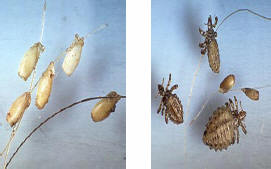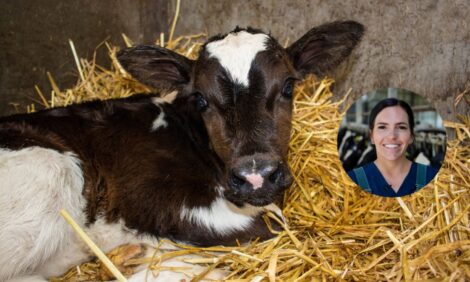



Cattle lice
Belinda Walker, Senior Regional Animal Health Manager, Surveillance & Biosecurity Operations, Gunnedah and published by NSW Department of Primary Industries - Lice irritate cattle, causing the cattle to bite, scratch and rub. This constant irritation can become a welfare issue. Lousy cattle may cause damage to fences, yards or trees which the cattle use as rubbing posts.Introduction
The coats of lousy cattle take on a rough scruffy appearance, and, at times, areas of skin are rubbed raw. This will reduce hide value at slaughter and be inconsistent with on-farm quality assurance programs.The effect of lice on the production and growth rate of cattle is a matter for continued debate. Conflicting results from many trials indicate that various factors interact to influence the degree to which lice affect cattle. Lice can be an important cause of economic loss when cattle are in poor condition or if infestations are heavy. If only a few animals in a mob are severely affected by lice, always look for an underlying cause. Diseased or nutritionally stressed animals will develop more severe lice infestations than healthy animals.
Characteristics
There are two types of cattle lice: biting lice and sucking lice.Although there are six species of cattle lice in Australia, only four are common in New South Wales.
Biting lice
Biting lice feed on skin debris and can cause severe irritation. The cattle biting louse (Bovicola bovis) is a reddish-brown louse about 2 mm long with a brown head. It is mostly found on the neck, shoulders, back and rump.Sucking lice
 Lice and eggs of Haematopinus eurysternus |
- The short-nosed cattle louse (Haematopinus eurysternus) is dark-grey. The female is 3.5–5 mm long. The male is smaller. It is mostly found around the cattle’s eyes and in the long hair around the neck and tail, but in heavy infestations it can occur anywhere in the hair coat. In summer it is found in and around the ears and under the tail.
- The long-nosed cattle louse (Linognathus vituli) is bluish-black and about 2.5 mm long. Like the short-nosed cattle louse it may be found anywhere in the hair coat including the neck, dewlap, inner thigh and scrotum.
- The tubercle-bearing louse (Solenopotes capillatus) is the smallest louse. At only 1.2 mm long. It has a brown head and a bluish abdomen. It is usually found around the head and neck in distinct dark clusters.
The life cycle
The life cycles of all species are similar. Eggs are laid by the female and glued to hair shafts, and take 8–19 days to hatch as nymphs. The nymphs undergo three moults on the beast, and develop into adults. The entire life cycle takes 3–6Spread
Lice are spread entirely by direct contact between cattle. The lice and their eggs survive for only a few days if removed from cattle. Cattle lice cannot live on other species of farm animals.Populations
Lice populations are highest in winter and lowest in summer. Cooler skin temperatures are associated with heavier lice infestations. The denser winter coat and cooler weather favours survival of lice. It appears that well-fed healthy cattle do not develop heavy lice infestations and that those lice present do not adversely affect performance. The number of lice tends to increase as nutrition for the cattle becomes poorer. It is usually when cold weather is coupled with poorer nutrition in winter that heavy lice infestations can develop. Cattle in poor condition tend to carry heavier lice infestations, particularly if they have some other problem such as some sort of chronic disease. However, some cattle appear to have a high susceptibility to lice and are described as ‘louse carriers’. Differences in the greasiness of the hair coat of various cattle breeds has been suggested as a possible reason for perceived differences in susceptibility to lice. However, it is more likely that differences in lice burdens between individuals reflects immunological, nutritional or health status differences between animals.Control
Insecticides and regulationsThere are many commercially available insecticides registered for control of cattle lice. All must be used strictly in accordance with manufacturers’ directions. Read the label thoroughly. Pay particular attention to the withholding periods required for meat and milk production, and to compatibility with other treatments such as drenches. Refer to the cautionary notices at the end of this document.
- Maximum residue limits (MRLs) are set for chemical/food combinations by Australian law.
- Withholding periods (WHPs) are designed to ensure a safe time period between pesticide application and slaughter of livestock, so that any chemical residues that may exist in the final product (meat or milk) are below the MRL.
- Export slaughter intervals (ESIs) have been developed for the red meat industry through Meat and Livestock Australia to reflect the differences between domestic and overseas MRLs. ESIs may be quite different to WHPs. Produce destined for overseas markets must satisfy the ESI. Read the product label carefully before use and adhere to the WHP and ESI time intervals.
Treatment methods
Most insecticides registered for use on cattle are not very active against louse eggs. This means that after treatment, eggs can still hatch and continue the infestation. With some insecticides, a follow-up treatment 2–3 weeks later is necessary. This time interval is critical to achieve control, as it allows time for the eggs to hatch but not to mature into adults which will lay eggs themselves.The timing and frequency of treatments depend very much on individual circumstances. In many cases treatment in late autumn or early winter will give adequate control of cattle lice.
There are four methods of treatment available, but not all products control both biting and sucking lice, so check the label carefully and/or have the lice on your cattle identified. Spray-on and pour-on insecticides are probably the most widely used form of control, but insecticidal ear tags are also available. The injectable formulations of macrocyclic lactone (ML) worm drenches also control sucking lice.
Spray treatment
Hand spraying is practical for small numbers of cattle. Knapsack sprays, or any pump/spray unit with 0.7–0.8 mm spray nozzles capable of producing a ‘cone’ or ‘flat fan’ spray pattern, are suitable.Commercial power spray units are also available. These are generally walk-through systems with one to three spray ‘hoops’. Cattle must be walked slowly through them to ensure adequate wetting.
With all spraying methods, thorough wetting of the cattle with the insecticide is essential.
Pour-on treatment
With pour-on treatments a small amount of insecticide is applied to the animal’s back. Depending on the product chosen, some insecticide will be absorbed across the skin and be moved throughout the body. Sucking lice that feed on blood are poisoned as they feed. Insecticide that remains on the skin and in the hair coat is distributed by cattle grooming. This residue aims to kill biting and sucking lice that come in contact with it. Always follow the ‘Directions for use’ on the product label to ensure proper application.Ear tags
At the time of writing (January 2007) there were two ear tags registered to control lice:- Warrior®, which contains two organophosphates, and controls both biting and sucking lice;
- PYthon®, which contains a pyrethroid insecticide, and is only registered for the control of biting lice.
It is vital to remove (or replace) both types of ear tag after 3 months. Failure to do so will expose any new lice to sublethal doses of the product, which will allow selection for resistant lice.
Treatment by injection
As mentioned previously, some broad-spectrum injectable anthelmintics will control sucking lice but not biting lice. Read the product labels to identify a suitable product. It is important when using broad-spectrum pesticides to consider the impact of the treatment on non-target species such as dung beetles.Macrocyclic lactone (ML) products offer the added benefit of activity against lice when used to drench cattle for nematode infection. Conversely, if MLs are used to treat a louse infestation, the treatment will also affect any worms present. Make sure the treatment strategy used is compatible with your drench-resistance management program.
Is lice treatment necessary?
Many experiments have shown that the treatment of cattle that have light to moderate infestations is not economically justified in terms of improved growth rate and body condition. However, in recent years there has been increasing emphasis on hide quality, and there is evidence that the majority of hide damage occurs when cattle are scratching due to the presence of lice.If cattle are scratching because of lice, treatment is recommended. Besides improving hide quality, this will decrease the likelihood of damage to fencing and other fixtures that cattle tend to use as rubbing posts. Treatment is more likely to be necessary in winter, especially if nutrition is poor, and cattle are losing condition.
Cattlecare, the beef industry’s quality assurance program, requires that all reasonable steps be taken to improve hide quality, so producers who wish to become Cattlecare-accredited will need to control lice. An eradication program should be seriously considered.
Eradication
Another consideration is that if you are concerned only with control (i.e. you treat the cattle only until they stop scratching) and do not check that you are removing all lice, then you may be selecting for resistance.In the case of sheep lice, there is already widespread resistance to some of the treatments used, and there is no reason to assume that this will not also occur in cattle lice. The best way to delay the onset of resistance is to:
- follow the manufacturer’s instructions;
- ensure that you do not underdose;
- check that treatments have been fully effective.
- Treat all cattle with one of the treatments listed above, and ensure that you repeat the treatment according to the manufacturer’s instructions.
- Ensure that the dose rate is accurate. Preferably weigh all cattle, or a representative sample.
- Treat all cattle on the property at the same time, prior to calving. Choose a time when they are not stressed or in poor condition. OR If groups are treated separately, ensure that there is no contact possible between treated and untreated groups.
- Immediately after treatment, move treated groups to a paddock that has not had cattle in it for at least a week.
- Ensure that no contact with any neighbours’ cattle is possible, either through straying or through contact across fences.
- Check that treatment has been effective. No adult live lice should be found on the animals when they are brought in again for their second treatment, and there should be no live lice at all a few days after the second treatment.
- Consider treating in autumn, before louse numbers build up. This will allow a longer ‘test period’ of cold weather to follow, so that you are better able to gauge whether eradication has been successful.
© State of New South Wales 2006



